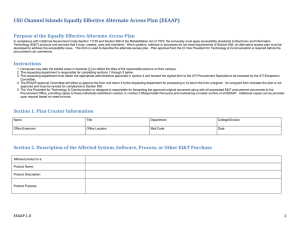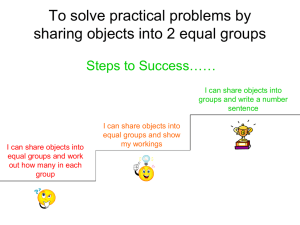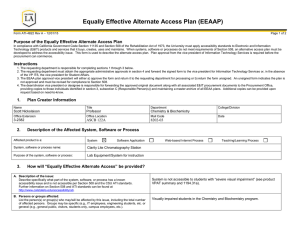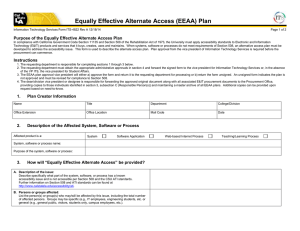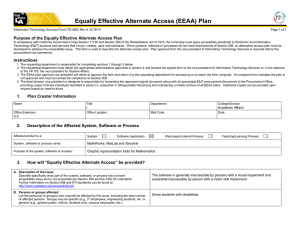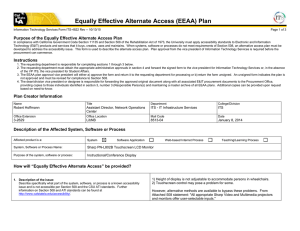Equally Effective Alternate Access Plan (EEAAP)
advertisement
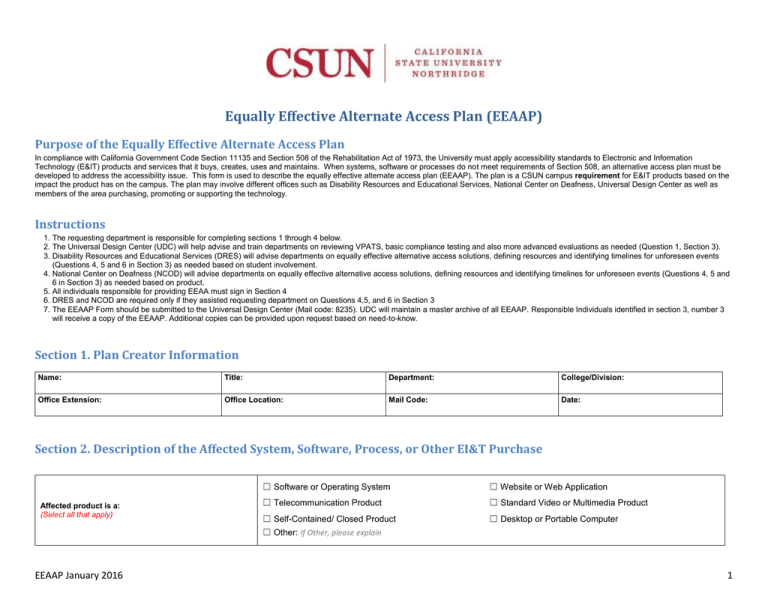
Equally Effective Alternate Access Plan (EEAAP) Purpose of the Equally Effective Alternate Access Plan In compliance with California Government Code Section 11135 and Section 508 of the Rehabilitation Act of 1973, the University must apply accessibility standards to Electronic and Information Technology (E&IT) products and services that it buys, creates, uses and maintains. When systems, software or processes do not meet requirements of Section 508, an alternative access plan must be developed to address the accessibility issue. This form is used to describe the equally effective alternate access plan (EEAAP). The plan is a CSUN campus requirement for E&IT products based on the impact the product has on the campus. The plan may involve different offices such as Disability Resources and Educational Services, National Center on Deafness, Universal Design Center as well as members of the area purchasing, promoting or supporting the technology. Instructions 1. The requesting department is responsible for completing sections 1 through 4 below. 2. The Universal Design Center (UDC) will help advise and train departments on reviewing VPATS, basic compliance testing and also more advanced evaluations as needed (Question 1, Section 3). 3. Disability Resources and Educational Services (DRES) will advise departments on equally effective alternative access solutions, defining resources and identifying timelines for unforeseen events (Questions 4, 5 and 6 in Section 3) as needed based on student involvement. 4. National Center on Deafness (NCOD) will advise departments on equally effective alternative access solutions, defining resources and identifying timelines for unforeseen events (Questions 4, 5 and 6 in Section 3) as needed based on product. 5. All individuals responsible for providing EEAA must sign in Section 4 6. DRES and NCOD are required only if they assisted requesting department on Questions 4,5, and 6 in Section 3 7. The EEAAP Form should be submitted to the Universal Design Center (Mail code: 8235). UDC will maintain a master archive of all EEAAP. Responsible Individuals identified in section 3, number 3 will receive a copy of the EEAAP. Additional copies can be provided upon request based on need-to-know. Section 1. Plan Creator Information Name: Title: Department: College/Division: Office Extension: Office Location: Mail Code: Date: Section 2. Description of the Affected System, Software, Process, or Other EI&T Purchase Affected product is a: (Select all that apply) ☐ Software or Operating System ☐ Website or Web Application ☐ Telecommunication Product ☐ Standard Video or Multimedia Product ☐ Self-Contained/ Closed Product ☐ Desktop or Portable Computer ☐ Other: If Other, please explain EEAAP January 2016 1 Product Name: Product Description: Product Purpose: Section 3. How will “Equally Effective Alternate Access” be provided? 1. Description of the issue: Describe specifically what part of the system, software, or process is a known accessibility issue and is not accessible per Section 508 and the CSU ATI standards. Further information on Section 508 and ATI standards can be found at CSU Accessible Electronic and Information Technology (E&IT) Procurement 2. Persons or groups affected: List the person(s) or groups who may/will be affected by this issue, including the total number of affected persons. Groups may be specific (e.g., IT employees, Engineering students, etc? or general (e.g., general public, visitors, students only, CSU employees, etc.). 3. Responsible person(s): List the name(s) and titles of the campus employee(s) who will be responsible for providing equally effective alternate access for the specified known accessibility issue as described in Number 4. 4. How will EEAA be provided: Describe in detail how the responsible department(s)/person(s) equally effective alternate access will be communicated and what will be provided. For example, “To access room availabilities, visitors can go to a different web page that contains the same information.” (If additional space is needed, attach a separate sheet) 5. EEAA Resources Required: List any resources required (including training, equipment, additional staff, etc.) to provide equally effective alternate access for the known issue. 6. Timeline for Unforeseen events: A timeline to plan create, implement, and follow up on plans for accommodation for access concerns/issues that are beyond campus policy and/or outside of the realm of the questions above. EEAAP January 2016 2 Section 4. Departmental Approvals By signing this request, you affirm that the plan has been reviewed and seems to be reasonable alternative for using the product. (All responsible individuals must sign the EEAAP. Provide space to allow multiple signatures) Plan Creator(s): Department Chair/ Manager: Date: Date: Date: Responsible Individual(s): Date: Date: Section 5: EEAAP Approval (Departments as appropriate) (Approval signatures are required for DRES and NCOD only if requesting department consulted with them.) DRES Approval: Date: NCOD Approval: Date: UDC Approval: Date: EEAAP January 2016 3

